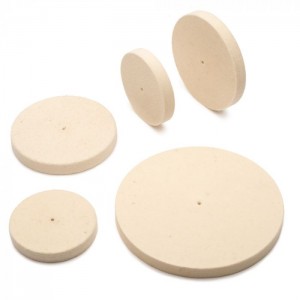In the highly competitive world of industrial manufacturing, every decision regarding tools and materials is carefully evaluated based on its cost – benefit ratio. Wool felt wheels, with their unique properties and wide range of applications, have emerged as a subject of intense cost – benefit analysis among industry professionals. Understanding the financial implications of using wool felt wheels can help businesses make informed decisions and optimize their operations.
On the cost side, the initial investment in wool felt wheels can vary depending on factors such as size, quality, and brand. High – end wool felt wheels with advanced features, such as enhanced durability or specialized fiber compositions, tend to be more expensive. However, it’s important to consider the long – term cost implications rather than just the upfront price. Wool felt wheels are known for their durability, and a high – quality wheel can last significantly longer than cheaper alternatives. This means that while the initial cost may be higher, the frequency of wheel replacements is reduced, resulting in lower overall maintenance costs over time.
Another cost factor to consider is the compatibility of wool felt wheels with different polishing compounds. Some high – performance compounds may be more expensive, and the choice of compound can impact the overall cost of the polishing process. However, using the right combination of wool felt wheel and polishing compound can lead to more efficient and effective results, reducing the time and resources required for each job. For example, a wool felt wheel that is specifically designed to work with a particular compound may achieve a better finish in fewer passes, saving both time and money.
When it comes to the benefits, wool felt wheels offer several advantages that can significantly impact a company’s bottom line. Firstly, their ability to achieve high – quality finishes on a wide range of materials can enhance the value of the final product. In industries such as jewelry, automotive, and consumer goods, a superior finish can command a higher price in the market, increasing profit margins. Secondly, the versatility of wool felt wheels allows for greater flexibility in production. A single wool felt wheel can be used on multiple materials and for various finishing tasks, reducing the need to invest in a large number of specialized tools.
In addition, the use of wool felt wheels can improve productivity. Their efficient polishing action can reduce the time required for each finishing operation, enabling companies to increase their output. This is particularly important in industries with high – volume production, where even a small reduction in processing time can lead to significant savings in labor costs and increased throughput.
Moreover, wool felt wheels contribute to a safer working environment. Their soft and non – abrasive nature reduces the risk of injury to workers compared to some other polishing tools. This can result in lower insurance premiums and fewer lost – time accidents, further adding to the overall benefits of using wool felt wheels.
A comprehensive cost – benefit analysis of wool felt wheels reveals that while there are upfront costs associated with their purchase, the long – term benefits in terms of durability, quality, productivity, and safety make them a valuable investment for many industrial applications. By carefully considering these factors, businesses can determine the most cost – effective way to incorporate wool felt wheels into their manufacturing processes and gain a competitive edge in the market.

Post time: Jun-09-2025
